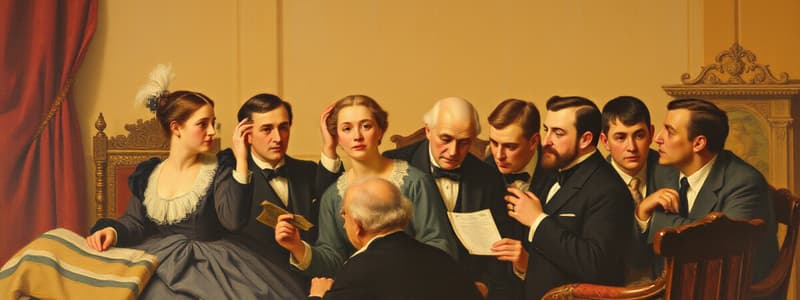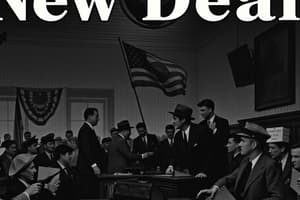Podcast
Questions and Answers
What is the New Deal coalition?
What is the New Deal coalition?
- A political term used exclusively in the 1970s
- A coalition of only Southern Democrats
- A group supporting the Republican candidates
- Alignment of interest groups supporting the New Deal (correct)
What did the New Deal coalition make the Democratic Party during its time?
What did the New Deal coalition make the Democratic Party during its time?
The Majority party
The New Deal coalition fell apart around the bitter factionalism during the _____ election.
The New Deal coalition fell apart around the bitter factionalism during the _____ election.
1968
Which of the following were partners in the New Deal coalition? (Select all that apply)
Which of the following were partners in the New Deal coalition? (Select all that apply)
What was one reason for the collapse of the New Deal coalition?
What was one reason for the collapse of the New Deal coalition?
What implications did the collapse of the New Deal coalition have?
What implications did the collapse of the New Deal coalition have?
Flashcards are hidden until you start studying
Study Notes
New Deal Coalition Overview
- The New Deal coalition refers to the diverse alignment of interest groups that supported the New Deal and the Democratic Party from 1932 until the late 1960s.
- It established the Democratic Party as the majority party during its existence.
- The coalition began to disintegrate during the 1968 election due to internal divisions but serves as a model for party activists today.
Key Partners in the Coalition
- Included a variety of groups: banking and oil industries, Democratic state party organizations, city machines, labor unions, and blue-collar workers.
- Also represented minorities including racial, ethnic, and religious groups, along with farmers, white Southerners, people on welfare, and intellectuals.
Factors Contributing to Its Disintegration
- The absence of a leader with the stature of Franklin D. Roosevelt; Lyndon Johnson attempted to revitalize the coalition.
- Emergence of contentious issues such as civil rights, the Vietnam War, affirmative action, and urban riots contributed to fragmentation within the coalition.
- The Republican Party capitalized on this division by appealing to voters with promises of lower taxes and crime control.
Consequences of the Coalition's Collapse
- Resulted in a shift in control of the political landscape, with the Republican Party gaining prominence.
- The Democratic Party evolved into a more working-class-oriented party post-collapse.
Studying That Suits You
Use AI to generate personalized quizzes and flashcards to suit your learning preferences.




